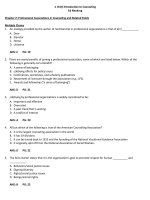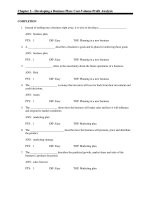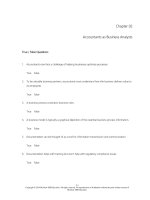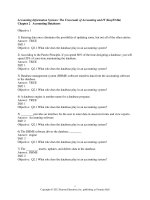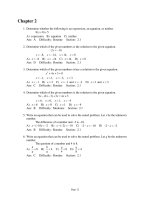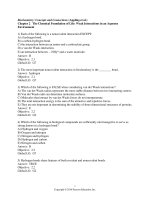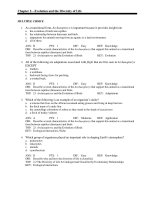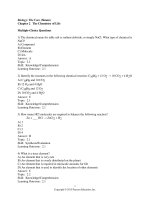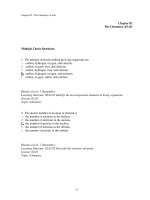Corporate finance 1st edition booth test bank
Bạn đang xem bản rút gọn của tài liệu. Xem và tải ngay bản đầy đủ của tài liệu tại đây (582.71 KB, 31 trang )
Booth, Cleary, & Drake / Corporate Finance
Test Bank
c02; Chapter 2: Financial Management
Multiple Choice
1. Which form of business would most likely describe the following, a college student who tutors other
students, a retired woman who babysits children, a teenager who mows lawns, and a party clown?
A. Partnership
B. Corporation
C. Sole proprietorship
D. Limited liability company
Answer
B
Difficulty
Easy
Learning outcome LO 2.1
Bloom’s taxonomy Describe
AACSB
Analytical skills
Feedback
A sole proprietorship is a business owned and operated by one person.
2. Which of the following is not a major form of business organization in the U.S.?
A. Partnership
B. Corporation
C. Sole Proprietorship
D. Public limited company
E. Limited liability company
Answer
D
Difficulty
Easy
Learning outcome
LO 2.1
Bloom’s taxonomy Remember
AACSB
Analytical skills
Feedback
In the U.S., the major forms of business organizations are the:
1. sole proprietorship;
2. partnership;
3. limited liability company; and
4. corporation.
Public Limited company would be a major form of business in the United Kingdom.
3. The major forms of business that have unlimited liability would best be described as:
A. sole proprietorships and partnerships.
B. corporations and subchapter s corporations.
C. limited liability partnerships and limited liability companies.
Answer
A
Difficulty
Easy
Learning outcome LO 2.1
Bloom’s taxonomy Describe
AACSB
Analytical skills
Copyright © 2014 John Wiley & Sons, Inc.
2-1
Booth, Cleary, & Drake / Corporate Finance
Feedback
Test Bank
Unlimited liability means that responsibility for obligations of a business that
extends beyond the original investment, including personal assets.
4. The major forms of business that have limited liability would best be described as:
A. partnerships.
B. sole proprietorships.
C. corporations and limited liability companies.
Answer
C
Difficulty
Easy
Learning outcome
LO 2.1
Bloom’s taxonomy Describe
AACSB
Analytical skills
Feedback
Limited liability is responsibility for only the initial amount of
the investment.
5. Your best friend wants to start a car detailing business to pay for college. Which of the following is a
disadvantage of sole proprietorships that he should consider?
A. Easy to form
B. Limited liability
C. Limited access to additional funds
D. Business income is taxed once, at the individual’s personal level.
Answer
C
Difficulty
Easy
Learning outcome LO 2.1
Bloom’s taxonomy Describe
AACSB
Analytical skills
Feedback
The sources of funds available for sole proprietorships are the same ones
that are available to individuals. No complicated finance options are
available—owners borrow from relatives and friends or, depending on their
credit rating, from the bank, through either a loan or a credit card.
6. Your best friend wants to start a car detailing business to pay for college. Which of the following is
an advantage of sole proprietorships that he should consider?
A. Easy to form
B. Unlimited life
C. Limited liability
D. Access to capital
Answer
A
Difficulty
Easy
Learning outcome LO 2.1
Bloom’s taxonomy Describe
AACSB
Analytical skills
Feedback
The big advantage of a sole proprietorship is that setting one up is easy—no
paperwork is involved, and the owner needs only to start doing business.
Copyright © 2014 John Wiley & Sons, Inc.
2-2
Booth, Cleary, & Drake / Corporate Finance
Test Bank
7. Flow-through taxation is a characteristic for all but the following forms of business?
A. Partnership
B. Corporation
C. Sole proprietorship
D. Limited liability company
Answer
B
Difficulty
Easy
Learning outcome LO 2.1
Bloom’s taxonomy Remember
AACSB
Analytical skills
Feedback
Flow-through taxation is where income flows directly to the owners as
taxable income and is not taxed at the business entity level.
8. Which of the following forms of business have flow-through taxation?
A. Apple Inc.
B. IBM Corporation
C. Deloitte & Touche LLP
D. Microsoft Corporation
Answer
C
Difficulty
Easy
Learning outcome LO 2.1
Bloom’s taxonomy Remember
AACSB
Analytical skills
Feedback
Flow-through taxation is where income flows directly to the owners as
taxable income and is not taxed at the business entity level. This does not
occur with corporations, but is the case for partnerships and limited
partnerships.
9. An advantage of the corporate form of business is its:
A. Limited life
B. Access to capital
C. Unlimited liability
Answer
B
Difficulty
Easy
Learning outcome LO 2.1
Bloom’s taxonomy Remember
AACSB
Analytical skills
Feedback
An advantage of a corporation is that it can issue stock.
10. An advantage of the partnership form of business is its:
A. Limited life
B. Access to capital
C. Unlimited liability
D. Flow-through taxation
Copyright © 2014 John Wiley & Sons, Inc.
2-3
Booth, Cleary, & Drake / Corporate Finance
Answer
Difficulty
Learning outcome
Bloom’s taxonomy
AACSB
Feedback
Test Bank
D
Easy
LO 2.1
Remember
Analytical skills
An advantage of a partnership is that income is only taxed at the owner’s level
(that is, flow-through taxation).
11. Which of the following statements would not be a reason Ford Motor Company uses the corporate
form of business?
A. Unlimited life
B. Limited liability
C. Access to capital
D. Business income is taxed once, at the individual owner’s level
Answer
D
Difficulty
Easy
Learning outcome LO 2.1
Bloom’s taxonomy Remember
AACSB
Analytical skills
Feedback
A disadvantage of corporations is that income is taxed at the corporate level
and at the owner’s level, when distributed.
12. Dentists’ offices, accounting firms, law firms, and physician’s offices are best described as examples
of which major type of business?
A. corporation
B. partnership
C. sole proprietorship
Answer
B
Difficulty
Easy
Learning outcome LO 2.1
Bloom’s taxonomy Describe
AACSB
Analytical skills
Feedback
A partnership is a business owned and operated by two or more people.
13. Your sister wants to start a tee shirt business on e-Bay with you to help pay for college tuition.
Which of the following is a disadvantage of partnerships that you both should consider?
A. Difficult to form
B. Separation of owners and managers
C. Unlimited liability for general partners
D. Income taxed at the business level and the owners’ level, when distributed
Answer
C
Difficulty
Easy
Learning outcome LO 2.1
Bloom’s taxonomy Describe
AACSB
Analytical skills
Copyright © 2014 John Wiley & Sons, Inc.
2-4
Booth, Cleary, & Drake / Corporate Finance
Feedback
Test Bank
A disadvantage of partnerships is unlimited liability for general partners.
14. A corporation that elects to be taxed as a partnership is best described as:
A. C corporation
B. limited liability company
C. subchapter S corporation
D. None of these describe corporations that are taxed as partnerships
Answer
C
Difficulty
Easy
Learning outcome LO 2.1
Bloom’s taxonomy Remember
AACSB
Analytical skills
Feedback
Sub S corporation - corporation that elects to be taxed as a partnership
15. Which of the following forms of business have limited liability for all its owners?
A. Partnership
B. C corporation
C. Sole proprietorship
Answer
B
Difficulty
Easy
Learning outcome LO 2.1
Bloom’s taxonomy Remember
AACSB
Analytical skills
Feedback
All shareholders of a corporation have limited liability.
16. Which of the following forms of business have unlimited liability for all its owner(s)?
A. C corporation
B. Sole proprietorship
C. Limited Partnership
Answer
B
Difficulty
Easy
Learning outcome LO 2.1
Bloom’s taxonomy Remember
AACSB
Analytical skills
Feedback
The owner of a sole proprietorship has unlimited liability.
All owners of a C corporation have limited liability.
The limited partners of a limited partnership have limited liability,
whereas the general partners have unlimited liability.
17. Which of the following forms of business partnership interests that are traded in the public market?
A. C corporation
B. Sole proprietorship
C. General partnership
D. Master limited partnership
Copyright © 2014 John Wiley & Sons, Inc.
2-5
Booth, Cleary, & Drake / Corporate Finance
Answer
Difficulty
Learning outcome
Bloom’s taxonomy
AACSB
Feedback
Test Bank
D
Easy
LO 2.1
Remember
Analytical skills
The master limited partnership has both general and limited partners, and the
partnership interests of the limited partners trade in markets.
18. Which of the following forms of business does not have flow-through taxation?
A. Partnership
B. C corporation
C. Sole proprietorship
D. Limited liability company
Answer
B
Difficulty
Easy
Learning outcome LO 2.1
Bloom’s taxonomy Remember
AACSB
Analytical skills
Feedback
The income of the corporation is taxed at the corporate level and once again
when paid out to owners in the form of dividends.
19. Your sister wants to start a tee shirt business on e-Bay with you to help pay for college tuition. All of
the following are advantages to partnerships that you should both consider, except ____________?
A. Easy to form
B. Access to capital
C. Business income is taxed once, at the individual partner’s level
Answer
B
Difficulty
Easy
Learning outcome LO 2.1
Bloom’s taxonomy Describe
AACSB
Analytical skills
Feedback
Partnerships access to capital, though easier than a sole proprietorship’s
access to capital is still limited because raising capital beyond the partners’
contributions and local banks may be challenging, especially in some
economic environments. And because a partnership is owned 100% by
partners, bringing in additional owners would not be possible unless the
partnership agreement is rewritten
20. Your parents inherit $100,000 and want to invest these funds for their retirement. They are very
concerned about entering into any form of investment from which they would incur liability. Which
of the following investment opportunities would not be appropriate for them?
A. Common stock of McDonald’s Corporation
B. General partner of an oil and gas limited partnership
C. Limited partner in a real estate limited liability company
D. Stock of British Petroleum, public limited company (PLC)
Copyright © 2014 John Wiley & Sons, Inc.
2-6
Booth, Cleary, & Drake / Corporate Finance
Answer
Difficulty
Learning outcome
Bloom’s taxonomy
AACSB
Feedback
Test Bank
B
Moderate
LO 2.1
Apply
Analytical skills
General partners make management decisions and have unlimited liability.
21. Your dad inherits $100,000 and wants to invest these funds for their retirement. They are very
concerned about business continuity and want to be able to pass on this investment to the next
generation of the family. Which of the following investment opportunities would not be
appropriate for them?
A. Common stock of McDonald’s Corporation
B. Food truck business operating as a sole proprietorship
C. Limited partner in a real estate limited liability company
D. Stock of British Petroleum, public limited company (PLC)
Answer
B
Difficulty
Moderate
Learning outcome
LO 2.1
Bloom’s taxonomy Apply
AACSB
Analytical skills
Feedback
A disadvantage of sole proprietorships is lack of continuity.
22. The form of business in which all partners share in the management and the profits of the business
and the income and the losses from the business are reflected on the individual owners’ tax returns
is best described as which of the following:
A. Corporation
B. Limited partnership
C. General partnership
D. Master limited partnership
Answer
C
Difficulty
Moderate
Learning outcome LO 2.1
Bloom’s taxonomy Remember
AACSB
Analytical skills
Feedback
general partnership - form of business in which all partners share in the
management and the profits of the business, and the income and losses from
the business are reflected on the individual owners’ tax returns.
23. Which of the following statements is not true?
A. There is no such thing as limited liability
B. Limited liability means liability only for the initial investment.
C. The general partner has limited liability as the operator of the business.
D. As long as the limited partners are not active in the business, they have the advantage of limited
liability.
Answer
C
Copyright © 2014 John Wiley & Sons, Inc.
2-7
Booth, Cleary, & Drake / Corporate Finance
Difficulty
Learning outcome
Bloom’s taxonomy
AACSB
Feedback
Test Bank
Moderate
LO 2.1
Describe
Analytical skills
The general partner has unlimited liability as the operator of the business.
24. A business organization which has limited liability, is a distinct legal entity, is immortal, and may
have issues of control would best be described as a:
A. corporation.
B. partnership.
C. sole proprietorship.
D. limited liability partnership.
Answer
A
Difficulty
Moderate
Learning outcome
LO 2.1
Bloom’s taxonomy Describe
AACSB
Analytical skills
Feedback
These characteristics all belong to a corporation.
25. The Bumble Bee Corporation had income before taxes of $1 million. Bumble Bee paid taxes at a flat
rate of 30% and paid 40 percent of its earnings to its shareholders in the form of cash dividends. If
its shareholders are taxed at the rate of 15 percent on dividend income, the effective tax rate on the
income generated by Bumble Bee, considering both corporate and individual taxation, is closest to:
A. 30.0%
B. 31.8%.
C. 34.2%.
D. 45.0%.
Answer
C
Difficulty
Difficult
Learning outcome
LO 2.1
Bloom’s taxonomy Analyze
AACSB
Analytical skills
Feedback
Corporate income
$1,000,000
Corporate tax
300,000
Income after tax
$700,000
Dividend income
Tax on dividends
Income after tax
$280,000
42,000
$238,000
Corporate tax
Individual tax
Total tax
$300,000
+42,000
$342,000
Effective tax
or
Copyright © 2014 John Wiley & Sons, Inc.
34.2%
2-8
Booth, Cleary, & Drake / Corporate Finance
Test Bank
0.30 + [ (1-0.3) × 0.4 × 0.15] = 34.2%
26. The Madison Corporation had income before taxes of $1 million. Madison paid taxes at a flat rate of
35% and paid 40 percent of its earnings to its shareholders in the form of cash dividends. If its
shareholders are taxed at the rate of 15 percent on dividend income, the effective tax rate on the
income generated by Madison, considering both corporate and individual taxation, is closest to:
A. 37.1%.
B. 38.9%.
C. 50.0%.
Answer
B
Difficulty
Difficult
Learning outcome
LO 2.1
Bloom’s taxonomy Analyze
AACSB
Analytical skills
Feedback
Corporate income
$1,000,000
Corporate tax
350,000
Income after tax
$650,000
Dividend income
Tax on dividends
Income after tax
$260,000
39,000
$221,000
Corporate tax
Individual tax
Total tax
$350,000
+39,000
$389,000
Effective tax
38.9%
or
0.35 + [ (1-0.35) × 0.4 × 0.15] =
38.9%
27. The Window Corporation had income before taxes of $1 million. Window paid taxes at a flat rate of
35% and paid 30 percent of its earnings to its shareholders in the form of cash dividends. If its
shareholders are taxed at the rate of 15 percent on dividend income, the effective tax rate on the
income generated by Window, considering both corporate and individual taxation, is closest to:
A. 35.000%
B. 36.575%.
C. 37.925%.
D. 50.000%.
Answer
C
Difficulty
Difficult
Learning outcome
LO 2.1
Bloom’s taxonomy Analyze
AACSB
Analytical skills
Feedback
Corporate income
$1,000,000
Corporate tax
350,000
Copyright © 2014 John Wiley & Sons, Inc.
2-9
Booth, Cleary, & Drake / Corporate Finance
Test Bank
Income after tax
$650,000
Dividend income
Tax on dividends
Income after tax
$195,000
29,250
$165,750
Corporate tax
Individual tax
Total tax
$350,000
+29,250
$379,250
Effective tax
37.925%
or
0.35 + [ (1-0.35 × 0.3 × 0.15] = 37.925%
28. Compare the effective tax rate of the following: A sole proprietorship ($25,000 in income, all of the
income is paid out, and the individual’s tax rate is 38%) to a corporation (the same $25,000 in
income, with all of the income paid out in dividends and a corporate tax rate of 35%. Individual tax
rate is 38%). What is the effective tax rate of the sole proprietorship? What is the effective tax rate
of the corporation?
Sole Proprietorship
Corporation
A.
38%
35%
B.
35%
38%
C.
35%
59.7%
D.
35%
61.6%
Answer
C
Difficulty
Difficult
Learning outcome LO 2.1
Bloom’s
Apply
taxonomy
AACSB
Analytical skills
Feedback
Effective tax rate of sole proprietorship is 35%.
Effective tax rate of corporation is calculated as follows:
Corporate income before taxes
Tax at 35%
Income after tax
$25,000
8,750
$16,250
Dividend income of individuals
Tax at 38%
Income after tax
$16,250
6,175
$10,075
Total taxes paid $8,750 + $6,175 = $14,925
$14,925 $25,000 income = 59.7% effective tax rate
29. Compare the effective tax rate of the following: A sole proprietorship ($100,000 in income, all of
Copyright © 2014 John Wiley & Sons, Inc.
2-10
Booth, Cleary, & Drake / Corporate Finance
Test Bank
the income is paid out, and the individual’s tax rate is 28%) to a corporation (the same $100,000 in
income, with all of the income paid out in dividends and a corporate tax rate of 30%. Individual tax
rate is 28%). What is the effective tax rate of the sole proprietorship? What is the effective tax rate
of the corporation?
Sole Proprietorship
Corporation
A.
30%
28%
B.
28%
30%
C.
28%
49.8%
D.
28%
49.6%
Answer
D
Difficulty
Difficult
Learning outcome LO 2.1
Bloom’s
Apply
taxonomy
AACSB
Analytical skills
Feedback
Effective tax rate of sole proprietorship is 35%.
Effective tax rate of corporation is calculated as follows
Corporate income before taxes
Tax at 35%
Income after tax
$100,000
30,000
$70,000
Dividend income of individuals
Tax at 38%
Income after tax
$70,000
19,600
$50,400
Total taxes paid $30,000 + $19,600 = $49,600
$49,600 $100,000 = 49.6% effective tax rate
30. The goal of the business enterprise is to maximize:
A. net profit.
B. net income.
C. economic profit.
Answer
C
Difficulty
Moderate
Learning outcome LO 2.2
Bloom’s taxonomy Remember
AACSB
Analytical skills
Feedback
Economic profit is the difference between revenue and expenses after
considering the opportunity cost of funds.
31. The goal of the business enterprise is to maximize:
A. net income.
B. economic profit.
C. earnings before interest and taxes.
Answer
B
Copyright © 2014 John Wiley & Sons, Inc.
2-11
Booth, Cleary, & Drake / Corporate Finance
Difficulty
Learning outcome
Bloom’s taxonomy
AACSB
Feedback
Test Bank
Moderate
LO 2.2
Remember
Analytical skills
Economic profit is the difference between revenue and expenses after
considering the opportunity cost of funds.
32. The goal of the business enterprise is to maximize:
A. revenues.
B. total assets.
C. owners’ wealth.
D. the book value of shareholders’ equity.
Answer
C
Difficulty
Moderate
Learning outcome LO 2.2
Bloom’s taxonomy Remember
AACSB
Analytical skills
Feedback
The goal is to maximize the wealth or equity of the owners.
33. Which of the following is most likely considered an externality with respect to a business entity?
A. Maximizing the value of shareholders’ wealth.
B. Managers using company assets for personal use.
C. Closing a plant, laying-off a significant portion of a town’s population.
Answer
C
Difficulty
Moderate
Learning outcome LO 2.2
Bloom’s taxonomy Remember
AACSB
Analytical skills
Feedback
Externalities are effects that extend outside of the company.
34. Which of the following takes into account takes into account the opportunity cost of funds?
A. Net profit
B. Economic profit
C. Accounting profit
Answer
Difficulty
Learning outcome
Bloom’s taxonomy
AACSB
Feedback
B
Moderate
LO 2.2
Remember
Analytical skills
Economic profit is the difference between revenue and expenses after
considering the opportunity cost of funds.
35. In the agency relationship between shareholders and management,
Copyright © 2014 John Wiley & Sons, Inc.
2-12
Booth, Cleary, & Drake / Corporate Finance
Test Bank
A. shareholders are agents of the managers.
B. managers are agents of the shareholders.
C. neither managers nor shareholders are agents.
Answer
B
Difficulty
Easy
Learning outcome LO 2.3
Bloom’s taxonomy Remember
AACSB
Analytical skills
Feedback
In the agency relationship, managers are the agents of the shareholders (who
we often refer to as the principals in the agency relationship).
36. An issue or conflict that arises due to potential divergence of interest between managers,
shareholders, and creditors is best described as a(n):
A. agency problem.
B. business problem
C. personal problem.
D. employment problem.
Answer
A
Difficulty
Easy
Learning outcome LO 2.3
Bloom’s taxonomy Remember
AACSB
Analytical skills
Feedback
agency problem - issue or conflict that arises due to potential divergence of
interest between managers, shareholders, and creditors
37. Which of the following statements about weighted average cost of capital is not true?
A. It is the marginal cost of funds
B. It measures profits and returns and is preferred by managers.
C. It is calculated as the weighted average of the costs of debt, preferred equity, and common
equity.
D. Shareholders compare it to return on a project to determine if their money is best being used by
the company or should be paid out to shareholders.
Answer
Difficulty
Learning outcome
Bloom’s taxonomy
AACSB
Feedback
B
Easy
LO 2.3
Describe
Analytical skills
Weighted average cost of capital (WACC) is a marginal cost of funds, but it is
not a measure of profits and returns.
38. If the management of a company cannot invest in investment projects that return more than what
the suppliers of capital require, the company should:
A. invest the funds in risk-free securities.
B. put the funds to work as best as possible.
Copyright © 2014 John Wiley & Sons, Inc.
2-13
Booth, Cleary, & Drake / Corporate Finance
Test Bank
C. pay out the funds to be reinvested by shareholders.
Answer
C
Difficulty
Easy
Learning outcome LO 2.3
Bloom’s taxonomy Describe
AACSB
Analytical skills
Feedback
Weighted average cost of capital (WACC) is a marginal cost of funds; if the
company cannot invest to provide the required rate of return on its
investments, it should pay out these funds to shareholders.
39. Jeffrey R. Immelt, CEO of General Electric, earned $3,300,000 in base salary, $5,800,000 in cash
bonus, and $4,713,000 in stocks granted in 2007. The compensation of Mr. Immelt is an example of
which of the following:
A. insider trading.
B. monitoring cost.
C. compensation scheme to encourage him to act in the best interest of shareholders.
Answer
C
Difficulty
Easy
Learning outcome LO 2.3
Bloom’s taxonomy Describe
AACSB
Analytical skills
Feedback
Agency costs are costs associated with agency problems, corporate
governance – set of processes and procedures established to manage the
organization in the best interests of its owners. Compensation schemes such
as this are intended to encourage managers to act in the best interest of
shareholders.
40. Which of the following in not a primary concern from the point of view of a company’s
management?
A. Minimize risk
B. Market value of equity
C. Maximize earnings per share
D. Maximize accounting return on investment
Answer
B
Difficulty
Moderate
Learning outcome LO 2.3
Bloom’s taxonomy Describe
AACSB
Analytical skills
Feedback
Management is more concerned with things they have some control over like
risk, earnings per share, and return on accounting investment. Management
does not have control over market value of equity and therefore this is not a
primary concern.
41. The framework for analyzing long-term investment or asset decisions is best described by the
following:
Copyright © 2014 John Wiley & Sons, Inc.
2-14
Booth, Cleary, & Drake / Corporate Finance
Test Bank
A. Cost of capital
B. Working capital
C. Internal rate of return
D. Capital budgeting or capital expenditure
Answer
D
Difficulty
Easy
Learning outcome
LO 2.4
Bloom’s taxonomy Remember
AACSB
Analytical skills
Feedback
capital budgeting or capital expenditure - analysis framework for analyzing investment
or asset decisions
42. When we talk about capital structure, this refers to:
A. the cash, inventory, and accounts receivable.
B. mix of debt and equity to finance an enterprise.
C. the investment in plant, property and equipment.
Answer
B
Difficulty
Easy
Learning outcome LO 2.4
Bloom’s taxonomy Apply
AACSB
Analytical skills
Feedback
capital structure – mix of debt and equity used to finance an enterprise
43. Which of the following would most likely not be a financing decision?
A. The Coca Cola company buys Pepsi.
B. Pfizer buys back $500,000 in common stock.
C. Rosetta Stone does a public offering of its stock.
D. McDonald’s issues $40,000,000 in corporate bonds.
Answer
A
Difficulty
Easy
Learning outcome
LO 2.4
Bloom’s taxonomy Describe
AACSB
Analytical skills
Feedback
A would be an investment decision.
44. Which of the following would not likely be considered an investment decision?
A. Bank of America acquired Merrill Lynch
B. LEGOLAND opened a new park in Orlando
C. Facebook completes a public offering of its stock
D. James Madison University bought a former hospital to turn into classrooms
Answer
C
Difficulty
Easy
Learning outcome
LO 2.4
Bloom’s taxonomy Apply
AACSB
Analytical skills
Copyright © 2014 John Wiley & Sons, Inc.
2-15
Booth, Cleary, & Drake / Corporate Finance
Feedback
Test Bank
C would be a financing decision.
45. The mix of debt and equity that is used to finance a business enterprise is best described as the
enterprise’s:
A. assets.
B. working capital.
C. capital structure.
D. capital expenditures
Answer
C
Difficulty
Easy
Learning outcome
LO 2.4
Bloom’s taxonomy Apply
AACSB
Analytical skills
Feedback
Capital structure is the mix of long-term sources of funds.
46. The uncertainty associated with the use of debt to finance a business enterprise is best described as:
A. financial risk.
B. business risk.
C. operating risk.
Answer
A
Difficulty
Easy
Learning outcome
LO 2.4
Bloom’s taxonomy Apply
AACSB
Analytical skills
Feedback
Capital structure is the mix of long-term sources of funds.
47. Which of the following is associated with how a company finances its assets?
A. financial risk.
B. business risk.
C. operating risk.
Answer
A
Difficulty
Easy
Learning outcome
LO 2.4
Bloom’s taxonomy Apply
AACSB
Analytical skills
Feedback
Financial risk is the volatility of earnings to owners; the more
debt in the capital structure, the more financial risk.
True-False
48. Corporations are not specific to the U.S.
A. True
B. False
Copyright © 2014 John Wiley & Sons, Inc.
2-16
Booth, Cleary, & Drake / Corporate Finance
Answer
Difficulty
Learning outcome
Bloom’s taxonomy
AACSB
Feedback
Test Bank
A
Moderate
LO 2.1
Describe
Analytical skills
A corporation is easy to recognize because it has Inc. for incorporated, Ltd. for
limited, or, in Europe, PLC for private limited corporation or AG for
Aktiengesellschaft, after its name.
49. Income is taxed at only one level, the owners’ individual income, for corporations.
A. True
B. False
Answer
B
Difficulty
Easy
Learning outcome LO 2.1
Bloom’s taxonomy Describe
AACSB
Analytical skills
Feedback
Corporations’ income is taxed at the corporate level and at the owner’s level,
when distributed.
50. If limited liability is your primary concern, one should not become a limited partner?
A. True
B. False
Answer
B
Difficulty
Easy
Learning outcome
LO 2.1
Bloom’s taxonomy Apply
AACSB
Analytical skills
Feedback
Limited partners are passive investors with limited liability.
51. If limited liability is your primary concern, one should not become a general partner?
A. True
B. False
Answer
A
Difficulty
Easy
Learning outcome LO 2.1
Bloom’s taxonomy Apply
AACSB
Analytical skills
Feedback
General partners make management decisions and have unlimited liability.
52. At least one general partner is required for all partnerships?
A. True
B. False
Answer
A
Copyright © 2014 John Wiley & Sons, Inc.
2-17
Booth, Cleary, & Drake / Corporate Finance
Difficulty
Learning outcome
Bloom’s taxonomy
AACSB
Feedback
Test Bank
Easy
LO 2.1
Describe
Analytical skills
All partnerships have at least one general partner
53. The difference between general and limited partnerships is that general partnerships include only
general partners, while limited partnerships include both limited and general partners.
A. True
B. False
Answer
A
Difficulty
Moderate
Learning outcome LO 2.1
Bloom’s taxonomy Describe
AACSB
Analytical skills
Feedback
General partnership – all partners are general partners, limited partnerships both general and limited partners, with general partners making management
decisions and having unlimited liability, and the limited partners being passive
investors with limited liability.
54. The difference between a limited partnership and a master limited partnership is that the limited
partnership interests of the master limited partnership can be traded publicly.
A. True
B. False
Answer
A
Difficulty
Moderate
Learning outcome LO 2.1
Bloom’s taxonomy Describe
AACSB
Analytical skills
Feedback
master limited partnership - form of business in which there are general and
limited partners, with limited partner interests traded in the public market.
55. ABC partnership has $500,000 in income before taxes. The partnership pays out all of its income to
the partners. If individual income tax rates are 33% and the corporate tax rate is 30%, the effective
tax rate of the partnership is 33%.
A. True
B. False
Answer
A
Difficulty
Moderate
Learning outcome LO 2.1
Bloom’s taxonomy Describe
AACSB
Analytical skills
Feedback
Effective tax rate for partnership is the individual tax rate because of flowthrough taxation.
Copyright © 2014 John Wiley & Sons, Inc.
2-18
Booth, Cleary, & Drake / Corporate Finance
Test Bank
56. A limited liability company is a combination of some of the best features of both the partnership and
sole proprietorship forms of business.
A. True
B. False
Answer
B
Difficulty
Easy
Learning outcome LO 2.1
Bloom’s taxonomy Describe
AACSB
Analytical skills
Feedback
A limited liability company is a combination of some of the best features of
both the partnership and corporate forms of business.
57. Any company may become a limited liability company.
A. True
B. False
Answer
B
Difficulty
Moderate
Learning outcome LO 2.1
Bloom’s taxonomy Describe
AACSB
Analytical skills
Feedback
It depends on state laws, but generally insurance companies, banks, law firms,
and nonprofit organizations are prohibited from becoming LLCs.
58. The share of revenue from corporations in the U.S. is significantly higher than the share of revenues
from sole proprietorships and partnerships.
A. True
B. False
Answer
A
Difficulty
Moderate
Learning outcome LO 2.1
Bloom’s taxonomy Describe
AACSB
Analytical skills
Feedback
The most common form of business in the U.S. is the sole proprietorship.
Although there are fewer corporations, they account for the largest share of
revenue.
59. A stockholder is any party affected by the decisions and actions of an entity.
A. True
B. False
Answer
B
Difficulty
Easy
Learning outcome LO 2.2
Bloom’s taxonomy Remember
AACSB
Analytical skills
Copyright © 2014 John Wiley & Sons, Inc.
2-19
Booth, Cleary, & Drake / Corporate Finance
Feedback
Test Bank
A stakeholder is any party affected by the decisions and actions of an entity.
60. Economic profit is another name for accounting profit.
A. True
B. False
Answer
B
Difficulty
Easy
Learning outcome LO 2.2
Bloom’s taxonomy Remember
AACSB
Analytical skills
Feedback
Economic profit considers the opportunity cost of funds, whereas accounting
profit does not.
61. For a given company, economic profit will always be greater than accounting profit.
A. True
B. False
Answer
B
Difficulty
Easy
Learning outcome LO 2.2
Bloom’s taxonomy Remember
AACSB
Analytical skills
Feedback
Though economic profit includes opportunity costs, accounting profits are
subject to accounting principles that may overstate or understate the true
economic profit of a company.
62. A stakeholder is any party affected by the decisions and actions of an entity.
A. True
B. False
Answer
A
Difficulty
Easy
Learning outcome LO 2.2
Bloom’s taxonomy Remember
AACSB
Analytical skills
Feedback
A stakeholder is any party affected by the decisions and actions of an entity.
63. A stakeholder is any party affected by the decisions and actions of an entity.
A. True
B. False
Answer
A
Difficulty
Easy
Learning outcome LO 2.2
Bloom’s taxonomy Remember
AACSB
Analytical skills
Feedback
A stakeholder is any party affected by the decisions and actions of an entity.
Copyright © 2014 John Wiley & Sons, Inc.
2-20
Booth, Cleary, & Drake / Corporate Finance
Test Bank
64. The goal of management of a company is to enhance the owners’ wealth.
A. True
B. False
Answer
A
Difficulty
Easy
Learning outcome LO 2.2
Bloom’s taxonomy Remember
AACSB
Analytical skills
Feedback
The goal of management of a company is to enhance owners’ wealth.
65. In the agency relationship that involves a company’s management and its shareholders, the
shareholders are the agents.
A. True
B. False
Answer
B
Difficulty
Easy
Learning outcome LO 2.2
Bloom’s taxonomy Remember
AACSB
Analytical skills
Feedback
The shareholders are the principals and the managers are the agents.
66. The weighted average cost of capital is a marginal cost.
A. True
B. False
Answer
A
Difficulty
Easy
Learning outcome LO 2.3
Bloom’s taxonomy Remember
AACSB
Analytical skills
Feedback
The weighted average cost of capital is the average of the marginal costs of
the business’s different sources of capital.
67. The cost of providing stock options to motivate managers is an example of an indirect agency cost.
A. True
B. False
Answer
A
Difficulty
Easy
Learning outcome
LO 2.3
Bloom’s taxonomy Remember
AACSB
Analytical skills
Feedback
Indirect agency costs include such things as the cost of making suboptimal investments
and providing stock options to motivate managers.
Copyright © 2014 John Wiley & Sons, Inc.
2-21
Booth, Cleary, & Drake / Corporate Finance
Test Bank
68. Corporate governance is a set of policies and procedures that are intended to promote for the best
interests of the shareholders.
A. True
B. False
Answer
A
Difficulty
Easy
Learning outcome
LO 2.3
Bloom’s taxonomy Remember
AACSB
Analytical skills
Feedback
Corporate governance is intended to reduce agency costs.
69. Costs associated with producing financial statements and annual reports for investors and
shareholders are examples of indirect agency costs.
A. True
B. False
Answer
B
Difficulty
Easy
Learning outcome
LO 2.3
Bloom’s taxonomy Remember
AACSB
Analytical skills
Feedback
Direct agency costs include such things as costs associated with producing financial
statements and annual reports for investors and shareholder.
70. The interests of managers and shareholders are usually fundamentally the same.
A. True
B. False
Answer
B
Difficulty
Describe
Learning outcome
LO 2.3
Bloom’s taxonomy Remember
AACSB
Analytical skills
Feedback
The interests of managers and shareholders are usually fundamentally the different.
71. Weighted average cost of capital (WACC) is calculated as the weighted average of the costs of a
firm’s different sources of capital, such as debt, preferred equity, and common equity.
A. True
B. False
Answer
A
Difficulty
Remember
Learning outcome
LO 2.3
Bloom’s taxonomy Remember
AACSB
Analytical skills
Feedback
The weighted average cost of capital (WACC) is the marginal cost of funds, calculated
as the weighted average of the costs of the different sources of capital (that is, debt,
Copyright © 2014 John Wiley & Sons, Inc.
2-22
Booth, Cleary, & Drake / Corporate Finance
Test Bank
preferred equity, and common equity).
72. Incentive plans are used to affiliate the best interests of CEOs and senior managers with those of
shareholders.
A. True
B. False
Answer
A
Difficulty
Remember
Learning outcome
LO 2.3
Bloom’s taxonomy Remember
AACSB
Analytical skills
Feedback
Shareholders are more concerned with stock price, CEOs and managers are more
concerned with earnings. The use of incentives makes a rising stock price more in the
interest of CEOs and senior managers.
73. The set of processes and procedures established to manage the organization in the best interests of
its owners is best described as an operating agreement.
A. True
B. False
Answer
B
Difficulty
Remember
Learning outcome
LO 2.3
Bloom’s taxonomy Remember
AACSB
Analytical skills
Feedback
This would be corporate governance, a set of processes and procedures established to
manage the organization in the best interests of its owners.
74. The interests of CEOs and business managers can still be considered aligned with shareholders even
if on the downside CEOs and managers do not suffer along with shareholders.
A. True
B. False
Answer
B
Difficulty
Remember
Learning outcome
LO 2.3
Bloom’s taxonomy Describe
AACSB
Analytical skills
Feedback
The important point to remember is that the interests of managers and shareholders
are not aligned if, on the downside, managers do not suffer along with the
shareholders.
75. Stock options do not properly align the interests of CEOs and business managers with shareholders.
A. True
B. False
Answer
A
Copyright © 2014 John Wiley & Sons, Inc.
2-23
Booth, Cleary, & Drake / Corporate Finance
Difficulty
Learning outcome
Bloom’s taxonomy
AACSB
Feedback
Test Bank
Moderate
LO 2.3
Describe
Analytical skills
Problems with aligning management’s interests with shareholders’ include the
following:
Few companies require executives to own the stock after exercising an option,
so often the shares obtained with an option exercise are sold immediately.
Some companies reprice the options if the stock’s price is far under the
original exercise price, setting the exercise price much below the original price.
It is challenging to establish a plan that compensates executives for making
long-term strategy and investment decisions today that take the long-run view
of maximizing owners’ equity.
The important point to remember is that the interests of managers and shareholders
are not aligned if, on the downside, managers do not suffer along with the
shareholders.
76. Finance people believe that the market for corporate control, not managerial incentives, ascertains
that shareholder value creation is the company's objective.
A. True
B. False
Answer
A
Difficulty
Moderate
Learning outcome
LO 2.3
Bloom’s taxonomy Describe
AACSB
Analytical skills
Feedback
The best defense against a hostile takeover is a high stock price. This provides
management incentive to maximize equity value.
77. Finance people believe that managerial incentives, not the market for corporate control ascertains
that shareholder value creation is the company's objective.
A. True
B. False
Answer
B
Difficulty
Moderate
Learning outcome
LO 2.3
Bloom’s taxonomy Describe
AACSB
Analytical skills
Feedback
The best defense against a hostile takeover is a high stock price. This provides
management incentive to maximize equity value.
78. Agency costs may arise because managers may not act in the best interests of shareholders or
because they must be induced to act optimally.
A. True
B. False
Copyright © 2014 John Wiley & Sons, Inc.
2-24
Booth, Cleary, & Drake / Corporate Finance
Answer
Difficulty
Learning outcome
Bloom’s taxonomy
AACSB
Feedback
Test Bank
A
Easy
LO 2.3
Remember
Analytical skills
Agency costs are costs associated with agency problems that arise with the separation
of ownership and management of a business enterprise.
79. The investment in plant, property, and equipment are examples of operating assets.
A. True
B. False
Answer
B
Difficulty
Easy
Learning outcome LO 2.4
Bloom’s taxonomy Describe
AACSB
Analytical skills
Feedback
operating assets -short-lived assets that support the company’s long-term
investments.
80. Cash, inventory, and accounts receivable are examples of working capital.
A. True
B. False
Answer
A
Difficulty
Easy
Learning outcome LO 2.4
Bloom’s taxonomy Describe
AACSB
Analytical skills
Feedback
working capital - current, operating assets of a company; also known as
operating assets
81. Interest-bearing obligations of an enterprise are equity capital.
A. True
B. False
Answer
B
Difficulty
Easy
Learning outcome
LO 2.4
Bloom’s taxonomy Remember
AACSB
Analytical skills
Feedback
Debt capital is the interest-bearing obligations of an
enterprise.
82. Ownership interest of an enterprise is equity capital.
A. True
B. False
Copyright © 2014 John Wiley & Sons, Inc.
2-25
